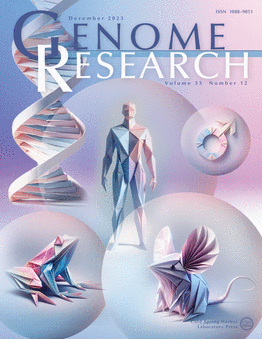LINE-1反转录转座子古代驯化的蛋白质编码外显子的诞生
IF 5.5
2区 生物学
Q1 BIOCHEMISTRY & MOLECULAR BIOLOGY
引用次数: 0
摘要
转座子,偶尔被驯化为新的宿主蛋白质编码基因,在脊椎动物中负责谱系特异性功能。L1是脊椎动物基因组中最活跃的转座子之一。尽管其丰富,但很少有脊椎动物蛋白L1共选择的例子被报道。在这里,我们描述了蛋白质异构体,其中L1反转录转座子通过选择性剪接作为蛋白质编码外显子整合到宿主基因中。L1 ORF1蛋白(ORF1p)是一种与L1 RNA结合的RNA结合蛋白,作为RNA伴侣,是逆转录转位所必需的。我们发现了一个肌球蛋白轻链4 (MYL4)的剪接变体,包含一个L1 orf1衍生的外显子,并编码L1 ORF1p和MYL4的转座子融合蛋白,在本研究中我们称之为“Lyosin”。分子进化分析表明,Lyosin亚型是在古生代龙目(爬行动物和鸟类)分化之前获得的。Lyosin的氨基酸序列经历了纯化选择,尽管它在某些谱系中丢失了,包括新鸟和蛇。Lyosin转录物在四种爬行动物的睾丸中表达,这表明它的功能不同于在心脏中表达的MYL4转录物。此外,综合序列搜索揭示了脊椎动物中三个基因L1 ORF1的其他剪接异构体。我们的研究结果表明,L1参与了谱系特异性蛋白的诞生,并暗示了L1 ORF1p以前未被认识的适应性功能。本文章由计算机程序翻译,如有差异,请以英文原文为准。
Birth of protein-coding exons by ancient domestication of LINE-1 retrotransposon
Transposons, occasionally domesticated as novel host protein-coding genes, are responsible for the lineage-specific functions in vertebrates. LINE-1 (L1) is one of the most active transposons in the vertebrate genomes. Despite its abundance, few examples of L1 co-option for vertebrate proteins have been reported. Here, we describe protein isoforms, in which the L1 retrotransposons are incorporated into host genes as protein-coding exons by alternative splicing. L1 ORF1 protein (ORF1p) is an RNA-binding protein that binds to L1 RNA and is required for retrotransposition by acting as an RNA chaperone. We identified a splicing variant of myosin light chain 4 (MYL4) containing an L1 ORF1–derived exon and encoding a transposon fusion protein of L1 ORF1p and MYL4, which we call “Lyosin” in this study. Molecular evolutionary analysis revealed that the Lyosin isoform was acquired before the divergence of Sauropsida (reptiles and birds) during the Paleozoic era. The amino acid sequence of Lyosin had undergone purifying selection although it was lost in some lineages, including the Neognathae birds and snakes. The Lyosin transcript was expressed in the testes of four reptilian species, suggesting that its function is different from that of the canonical MYL4 transcript expressed in the heart. Furthermore, comprehensive sequence searches revealed other splicing isoforms fused to the L1 ORF1 in three genes in vertebrates. Our findings suggest the involvement of L1 for the birth of lineage-specific proteins and implicate the previously unrecognized adaptive functions of L1 ORF1p.
求助全文
通过发布文献求助,成功后即可免费获取论文全文。
去求助
来源期刊

Genome research
生物-生化与分子生物学
CiteScore
12.40
自引率
1.40%
发文量
140
审稿时长
6 months
期刊介绍:
Launched in 1995, Genome Research is an international, continuously published, peer-reviewed journal that focuses on research that provides novel insights into the genome biology of all organisms, including advances in genomic medicine.
Among the topics considered by the journal are genome structure and function, comparative genomics, molecular evolution, genome-scale quantitative and population genetics, proteomics, epigenomics, and systems biology. The journal also features exciting gene discoveries and reports of cutting-edge computational biology and high-throughput methodologies.
New data in these areas are published as research papers, or methods and resource reports that provide novel information on technologies or tools that will be of interest to a broad readership. Complete data sets are presented electronically on the journal''s web site where appropriate. The journal also provides Reviews, Perspectives, and Insight/Outlook articles, which present commentary on the latest advances published both here and elsewhere, placing such progress in its broader biological context.
 求助内容:
求助内容: 应助结果提醒方式:
应助结果提醒方式:


